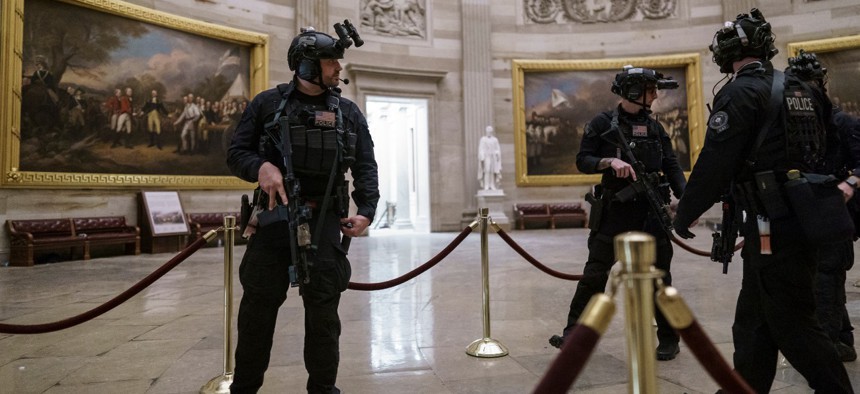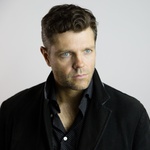
Members of the U.S. Secret Service Counter Assault Team walk through the Rotunda as they and other federal police forces responded as violent protesters loyal to President Trump stormed the U.S. Capitol on Wednesday. J. Scott Applewhite/AP
U.S. Capitol Now More Vulnerable As a Result of Wednesday’s Mob Attack, Former DHS Official Says
A lack of coordination among authorities was evident and will make securing the seat of legislature harder.
The mob assault on the U.S. Capitol marked the worst assault on the building that is, perhaps, most closely associated with the U.S. government since August 24, 1814, when British soldiers led by Vice Adm. Sir Alexander Cockburn entered the building by force and set fire to all they surveyed. One former senior DHS official said Wednesday’s events publicized a terrible lack of planning and coordination on behalf of the patchwork of bodies responsible for its security and advertised enormous vulnerabilities for all the world to see.
Elizabeth Neumann served as a senior advisor and Deputy Chief of Staff of the Department of Homeland Security under the Trump Administration resigning in protest this year. She said that Wednesday’s events show that key bodies in charge of security failed to properly coordinate beforehand or rehearse a response to a threat they’d never dealt with before but that was plainly visible. “Imagine, now overseas you have terrorists who would love to destroy the Capitol. They just saw how easy it was to penetrate. We just exposed a huge vulnerability,” she said.
So what would a proper response have looked like? Ideally, the reliable police presence that surrounds events like the Super Bowl, inaugurations and the like would have been in place. That means bringing together all of the different bodies that play some role in securing the building. It’s a patchwork of delicate jurisdictions. Because the Capitol Building is separate from both the city of D.C. and the executive branch, security officials must make special arrangements in advance to invite federal officers into the building to perform security functions.
While DHS can play a key role in protecting federal buildings from civil strife, protecting the U.S. Capitol is a somewhat more complicated task as it isn’t a “regular” federal building. It’s protected by the Capitol Police force, which is independently funded by Congress and distinct from other federal law enforcement bodies and from the D.C. police force. Rep. Tim Ryan, D-Ohio, who sits on an appropriations committee that funds for the Capitol Police, told reporters yesterday. “You can bet your ass that we’re going to get to the bottom of it...I think it’s pretty clear that there’s going to be a number of people who are going to be without employment very, very soon."
Better coordination would have enabled the Capitol Police to much more quickly call for backup from federal authorities, via FEMA’s Emergency Support Function 8, which, Neumann said, should have been activated immediately.
Before the event, authorities should have role-played and rehearsed what might happen on the electoral college certification day, which became an unusually (but not spontaneously) charged political event this year. “The fact that none of that prep happened. That’s concerning. It’s a failure in response and it's a failure in carrying out their duties,” she said. “When we have special national events like an election or an inauguration, there’s a joint command center, the Capitol Police participate, the DC police, there’s coordination.”
There was also a lack of credible information from authorities in the minutes and hours after the event took pace, she said. “I was noticing that [D.C. Mayor Muriel] Bowser, was the only official who did what incident protocols call for in terms of communication,” with the public.
The Capitol Police did finally put out a statement on Thursday, which addressed the shooting of a rioter inside the building as well as the explosive devices found near it. “The USCP had a robust plan established to address anticipated first amendment activities,” it states, somewhat unconvincingly.
Does Wednesday’s event suggest an intelligence failure on behalf of federal authorities like the Department of Homeland Security? It’s not an easy answer. Some of the rioters had posted about their intentions in various forums that were publicly viewable to reporters and others, boasting of a desire to assemble and “storm the capitol.” But reading or surveying threats in right-wing forums doesn’t give you the intelligence to know who will act on their words and who won’t. That’s especially true of the rally goers on Wednesday, which included people who attacked the Capitol Building but also thousands of other Americans who peacefully protested.
“You look at the pictures of the people on the planes coming in… there’s a difference between Ma and Pa Trumper,” and violent rioters, Neumann said.
That’s a big part of the problem in anticipating events like Wednesday’s: large crowd political events in which regular protestors are interspersed with people that are primed to violence and others who may just follow along with the crowd. It’s an altogether different sort of threat from what Neumann described as intricatly-planned “complex” forms of conventional terrorism, for which the United States has already developed strategies. The latter are in some ways easier to predict precisely because, in planning them, perpetrators leave clues about their targets and actual capabilities and intentions.
While some rioters had expressed some sort of intent it’s clear from their actions that they didn’t have an actual plan for what to do when they arrived inside the building other than take selfies and steal things from congressional offices.
Homeland Security officials that Neumann had been talking to in the days leading up to the rally expressed heightened alarm about what might happen during the event, she said. With self-appointed militia members announcing plans to congregate near the capitol, the level of planning and intent seemed to be greater than what observers had seen during previous events.
“A couple of days ago it was ‘this is maybe a bit more serious than (the 9 December event.) As the last few days have ticked by, with the President’s call, tension with [Vice President] Pence… You started seeing communications on social media that seemed more tactical,” she said. “‘We should string them all up’ is fairly common. ‘Let’s met at this time, bring your weapons,’ at very least, it suggests that they’re preparing for violence if not necessarily to commit it.”
Despite that, it’s clear that the Department of Homeland Security leadership didn’t take the threat seriously enough, as indicated by the fact that on the eve of a historic election certification, which saw thousands of angry political activists flooding into the nation’s capital, acting secretary Chad Wolf was in the Middle East. “That tells you all you need to know,” said Newman.
Wolf’s successor, Alejandro Mayorkas, whom President-elect Biden has picked to lead DHS, will face extra burdens securing the Capitol because of Wednesday’s events. The Capitol Police and other law enforcement agencies will not only have to completely overhaul security for the building and probably implement scores of new security measures, but make sure the world knows of it and finds the new defenses credible, said Neumann. “We’re going to have to publicize all the security improvements we put in place,” she said, in order to dissuade future attacks, foreign and domestic.
NEXT STORY: Viewpoint: This Is a Coup







